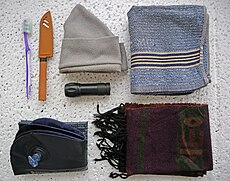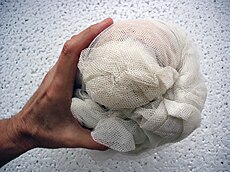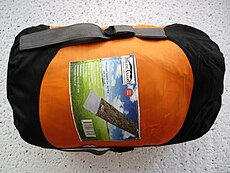Hobo tourism/Equipment

(total weight — not more than 10 kg.)

Used camping mat, polyethylene film, bedspread, inflatable pillow.

Similar equipment & mosquito net was used.
This chapter of the textbook examines the preparation of equipment needed for a traveler using budget methods of travel around the world and explains some nuances of its application in tropical and subtropical countries: the concept of hobo tourism, excludes routes, related to visiting polar climates regions.
The subject of hobo tourism should have a minimum of the most essential items, as travel in this format is sometimes fraught with dangers and is always accompanied by non-standard accommodation options, such as an open-air overnight stay, in the halls and staircases of buildings, joining the companies of native homeless and so on. where to have expensive or attracting the attention of potential robbers items — is not safe.
There is a special term characterizing travel easily — ultralight backpacking This method is used by ordinary (including not crossing the state borders) hikers, but if for them it is a matter of choice, then for t. n. international tramp — a necessity.
What to take with you?
[edit | edit source]- Backpack (small, preferably without lightnings).
- Sleeping pad (attached to the backpack from below — see photo).
- Polyethylene film for spreading under the sleeping pad, much larger than its dimensions (to protect the lower plane from dirt).
- Mosquito net.
- Blanket or sleeping bag.
- A small flashlight (you will need to sleep in abandoned buildings).
- First aid kit containing the minimum necessary medicines.
- Chlorine tablets (or manganese) for water purification.
- Insect repellent.
- Wet wipes (preferably anti-bacterial): sometimes they have to wipe not only hands, but also gifts of the jungle.
- A small towel (it will serve for washing and after taking a shower).
- Glue universal quick action (for emergency repair of shoes, backpack, etc.).
- A knife with a light handle.
- Threads, needle.
- Handkerchief.
- Spoon and mug (plastic).
- A duffel bag of thin cloth.
- A toothbrush and a paste in a small tube.
What to leave at home?
[edit | edit source]- The tent, it will become a burden for long journeys.
- Paper guides (and another books).
- Expensive photo and video equipment (as well as cheap but cumbersome).
- Large and heavy outerwear.
Certain recommendations
[edit | edit source]- The backpack should be roomy and comfortable, filled to weigh no more than 10 kg. (Some airlines charge an additional fee for exceeding the specified weight).
- In case of expected rain, you should find a canopy, in clear weather — sleep in the open. No tents!
- Sometimes the backpack must be left at the point of temporary dislocation (for example, hidden in the bushes) and wander with a duffel bag light.
- The lack of a smartphone can compensate for the native Internet clubs that are now available even in the poorest countries.
- Sleeping bag is necessary only in some cases (see example), usual, you can do without it.
- It is recommended to use objects for different purposes: windbreaker — as a pillow, etc.
- If the flight is due in winter and the return is scheduled for the warm season, the outer garments should be simply thrown away when boarding the aircraft or at the airport of arrival.
- If you expect to return in winter, you should take light demi-season clothing, allowing you to run from the airport terminal to the stop of the bus.
Quote
[edit | edit source]About use as «luggage store» hidden place on the roof of a high-rise house in Hong Kong, where the author had to spend the entire period of stay in the "city-country":
<...> my «sleeping place» was located at the door, facing the roof. Opening it, examined a small area and found a niche in the brick annex. Wrapping the backpack in a large plastic bag, I hid it in a stash and put some junk on top to disguise and sighed with relief. Of course, things can steal, and I can't explain to police that slept... like Karlsson. But, who does not risk — the one... does not travel around the globe, but sits at home...[1].
Gallery
[edit | edit source]In the first photo: toothbrush (12 g); knife (30 g); hat (33 g); flashlight (40 g); towel 30x70 cm. ( 90 g) ; inflatable pillow (115 g); scarf (95 g)
-
Approximate variant of the contents of the backpack
-
Mosquito net (300 g)
-
Inflatable travel pillow, 30x45 cm
-
A duffel bag (without contents — 60 g)
-
Sleeping bag in a pouch (1200 g)
-
Additional case of thin fabric — attaches to backpack (for sleeping mat)
References
[edit | edit source]- ↑ Pinchuk, Viktor. Six months by islands... and countries (in Russian). Russia: Brovko. p. 146 - 147. ISBN 978-5-9908234-0-2.





